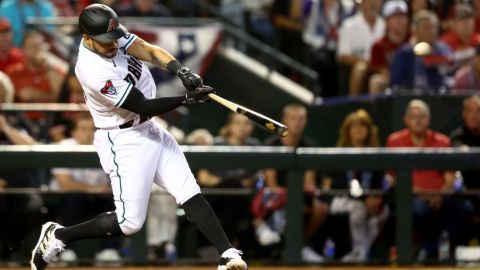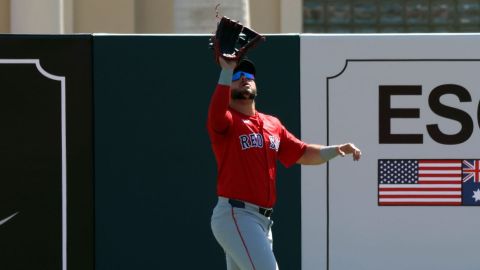The Red Sox have been on a never-ending quest to fill roster spots vacated by injured stars.
Just after the All-Star break, catcher Dusty Brown was recalled from Triple-A Pawtucket.
The following afternoon, on a Sunday that saw temperatures soar into the 90s under relatively cloudless skies, Brown receives his first major league start. In addition to the usual nerves, his preparation to catch Jon Lester for the first time in his career and scouting the high-powered Texas Rangers, the weather presented an undeniable concern for Brown.
Wearing the catching gear, squatting dozens of times and patrolling the most demanding position on the field under a scorching sun can cause Brown to lose as much as 10 pounds of water weight in the span of a few hours.
To ensure his body can withstand such a blow, Brown prepares early.
"The first thing is try to make sure you’re hydrated before you go out there," said the 28-year-old, who made a memorable relief appearance for the Red Sox in a rout last year. "If you’re a little underhydrated or dehydrated before you even start, it’s gonna be tough to be able to stay hydrated enough during the game.
"So try and hydrate before, and once you get out there, just crush water between innings."
Essentially, Brown plays catch-up with the sweat that pours out under such circumstances. On days like this one, he is usually playing from behind. Overhydration, an issue that pops up in marathon races when runners drink too much water, is rarely an issue for Brown. The sweat is just too rapid.
"It’s hard for me to do that because I lose so much water weight when I catch, so even when I rehydrate and try and get my hydration up, a lot of times it never even gets there, so I just try to get as much fluids in me as I can," he said. "There’s been games where even if I’m drinking water the whole game, I come back in and I’m 10 pounds lighter.
"It’s crazy," he added. "You can only drink so much water during a game."
The Red Sox dugout is equipped with a steady supply of bottled water, coolers filled with ice and water and electrolyte-laced sports drinks — a collection of fluids that are put in place hours before first pitch in order to help the players maintain hydration levels during pregame drills and batting practice.
Inside the clubhouse sits a large refrigerator with a glass door showcasing dozens of different kinds of drinks. Its door was constantly open on the day Brown got his first start.
Yet, even on cooler days, when one’s duty is not to catch major league pitching but simply catch up on chores around the house, hydration remains a vital factor in a person’s everyday health.
"The average daily requirement for healthy individuals is 10 to 12 eight-ounce cups, which most people meet through the foods and beverages they consume ," says Carine Corsaro, exercise physiologist at the Tanger Be Well Center at Beth Israel Deaconess Medical Center.
She notes people need more water when exercising. According to the American College of Sports Medicine, the recommendation during exercise is 16 ounces prior to exercise, four ounces every 20 minutes during exercise and 16 ounces of fluid for every pound of weight lost during exercise.
While hydrating is critical in hot weather, it's important even when you aren't sweating. Corsaro recommends keeping liquid at arms reach regardless of the activity and taking frequent sips.
"If you aren't hydrated, you can feel fatigued," she said. "The real concern is when an electrolyte imbalance occurs. That can lead to dizziness, cramping and serious health complications."
For athletes, it’s a constant concern and has become ingrained in the sports culture. Thanks in no small part to Gatorade and the “Be Like Mike” campaigns, countless fans with a little bit of thirst and a desire to emulate their heroes rush to the coolers.
When it’s all said and done for Brown, his commercial image is the furthest thing from his mind. He has to ensure that the loss of fluids does not cause too much cramping, which has become so bad he can find agony in a sneeze.
Brown recalls a game that took place when he was playing Single-A ball in Augusta, Ga., back in 2003. On a day when temperatures were in the triple digits with humidity levels near 90 percent, he caught all 12 innings of a game.
"In the 12th inning, I made a throw and my whole right leg cramped up at the same time," he said. "Afterward, I just had to sit in a cold whirlpool for 20 minutes. I ended up losing like 15 pounds."
That won’t happen if you toil in an air-conditioned office, but when you’re a major league catcher wearing the “tools of ignorance” on hot summer days, it’s a daily concern.
"Part of the game," Brown said. “Part of the job."



